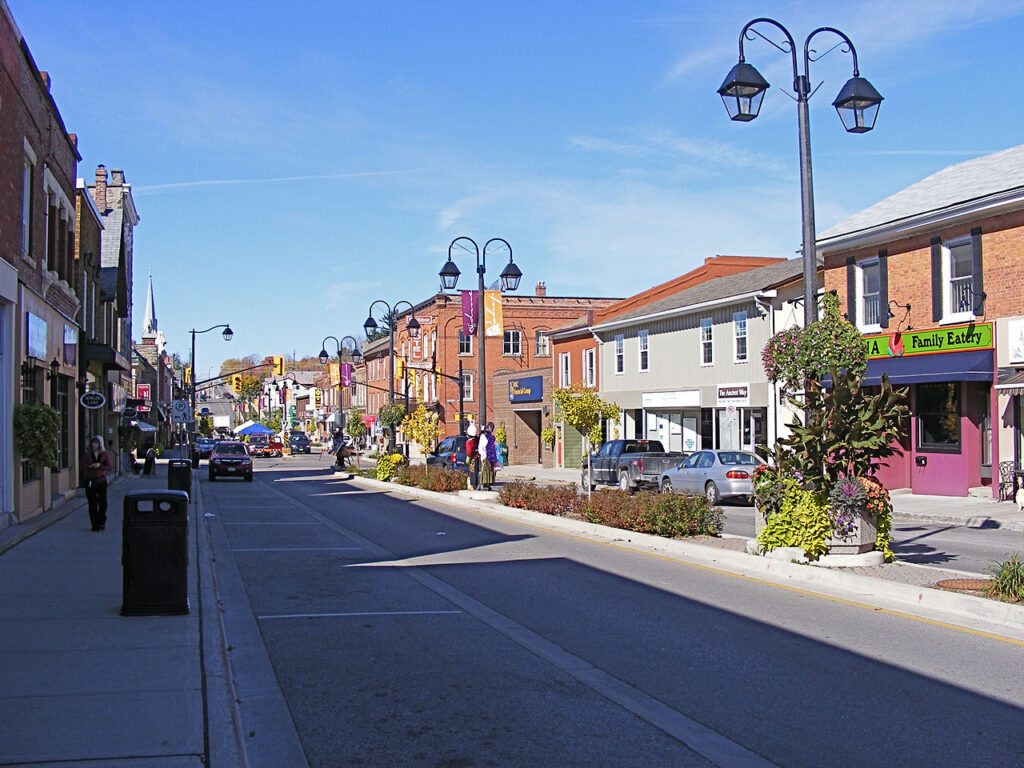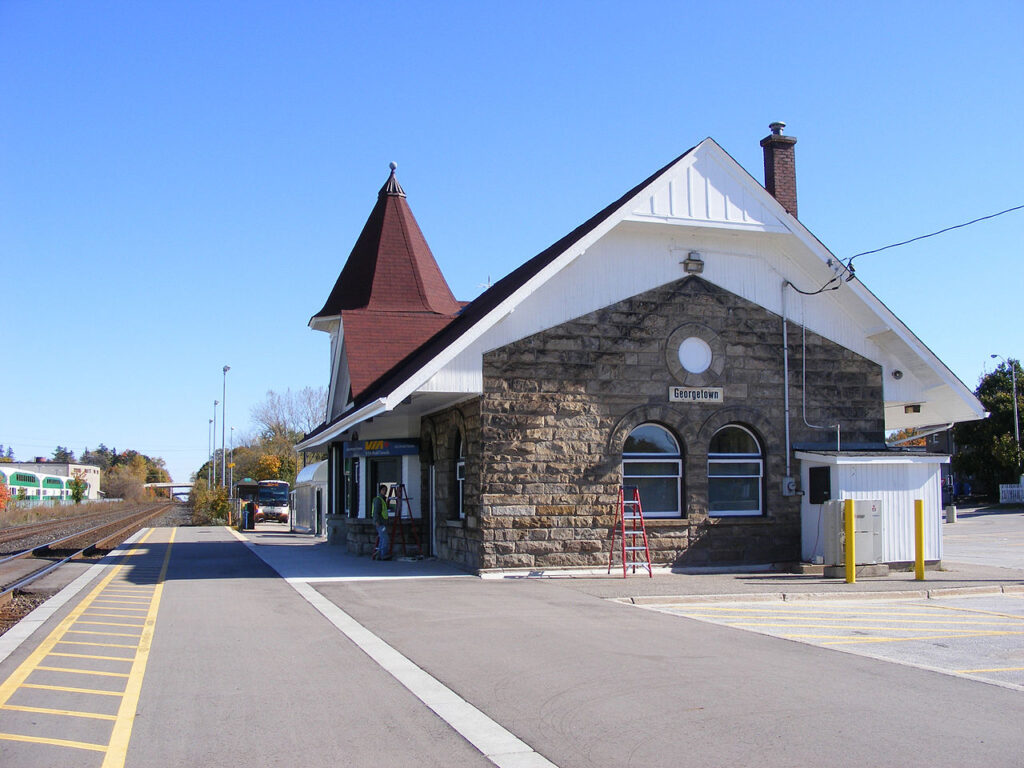Located on the banks of the Credit River and surrounded by the rolling hills of the Niagara Escarpment, Georgetown is a GTA gem. Georgetown has the largest population centre in the Town of Halton Hills.
The hilly landscape is featured by farmland. Halton Hills is one of the largest agricultural regions in the GTA and you’ll find barns that date back centuries.
Georgetown is a small town located 45 kilometres from Toronto and 60km outside of Hamilton. This means that it’s an easy commute from Georgetown into bigger communities.
The town is rich in history and well-equipped with modern amenities. It’s an excellent choice for people looking to live the small town lifestyle without sacrificing access to the big city.
Contact us to find out more about buying or selling property in Georgetown. Frank Leo and Associates has 3 decades of experience in GTA real estate, and we’ll be happy to help you learn more.

The History of Georgetown
Indigenous people inhabited the region that is now known as Halton Hills for centuries before the arrival of Europeans. In 1818, British officials acquired the land from the Mississauga Nation. The British surveyed the territory and called it Esquesing Township the following year.
One of the men who the officials hired to survey the land was named Charles Kennedy. He was the son of a Loyalist, and a veteran of the War of 1812. He identified some of the best land in the Township and, in 1819, five of his brothers moved into the region.
George Kennedy was one of the brothers and he established a farm and a woollen mill on Silver Creek.
Settlers dammed Silver Creek and built a sawmill, a woollen mill, and a gristmill. This formed the centre of the budding settlement that was eventually named “Hungry Hollow”.
In 1828, the area was connected to Toronto via the York to Guelph Road (now Highway 7).
It wasn’t until 1837 that the town gained the name of Georgetown. The Barber brothers named the town. They bought George Kennedy’s farm and mill that year. The Barbers named the town after George Kennedy.
The Barbers were industrialists who converted Kennedy’s mill into a paper mill. Their mill became the biggest producer of wallpaper in Ontario. In the 1880s, Barber Mills became the first factory in North America to harness hydroelectric power for production.
The Toronto to Sarnia line of the Grand Trunk Railway opened with a stop in the community in 1856.
Georgetown became a village in 1865 and incorporated as a town in 1922.
The Turn of the Century in Georgetown
Georgetown’s population grew steadily throughout the turn of this century, due in part to its new industries. A tannery and lumberyard were among many business people who settled here after 1900
The early 20th Century saw an expansion on infrastructure for transportation as well as industrial development that led several different types of products through Georgetown’s gates including leather goods made by hand or machine; boxes made from old wood scraps and more.
By 1910, the population of the town had grown to about 1,400 people. It was a prosperous town that was notable for its connection to the electrical grid and its gravitational waterworks system. This system provided a bountiful supply of pure drinking water from Silver Creek. There were many industrial and business opportunities in the town.
The Toronto Suburban Railway connected Georgetown and Toronto with a direct rail link in 1917.
Georgetown gained a world-famous resident in 1926 when Lucy Maud Montgomery settled in the nearby community of Norval. The house where the author of Anne of Green Gables lived is now a popular museum and tourist attraction.
The citizens of Georgetown also organized the first refugee sponsorship program in Canada. Between 1923 and 1927, the townspeople sponsored the immigration of 109 Armenian boys. The boys were orphans who had survived the Armenian Genocide. When they arrived in Georgetown, the boys were placed with local families where they learned farming skills. Most of the boys became Canadian citizens and stayed in Canada for the rest of their lives.
Frank Leo and Associates has been helping people find the house of their dreams and get the best price for their property for 30 years. Contact us if you want to learn more about Georgetown real estate, or browse up to date listings online.
Suburban Development in Georgetown
After the Second World War, the urban landscape of Georgetown began to change. Farmland was increasingly developed into housing subdivisions. The population of the town swelled as people were enticed to move into the new houses. The town’s proximity to larger communities of the GTA made it an ideal place for commuters.
One of the most important developers in the post-war housing boom was a man named Rex Heslop. Heslop was behind many large suburban developments in the GTA, including Rexdale in Etobicoke. He came to Georgetown in 1955 and built a modern subdivision in the southeast of the town. Heslop named the neighbourhood Delrex after himself. He also named three of the streets, Rexway, Heslop, and Delrex, after himself for good measure.
A few years later, in 1962, developers converted the Moore farm on the west end of the town into a housing development. They named this development Moore Park. At this time there were around 10,000 people living in Georgetown. A hospital was built in order to service them.
Georgetown amalgamated with Acton and the rest of Esquesing Township to form the Town of Halton Hills in 1974. The Toronto Suburban Railway ceased operation in 1931 due to the Great Depression. But in 1974 the first GO train arrived in Georgetown, once again providing the city with a commuter rail link with Toronto.
Housing development continued in the area. The Georgetown South residential expansion broke ground in 1989. That year, the Town of Halton Hills built its municipal building in the south of Georgetown, on Maple Avenue.
Georgetown continues to grow to this day. It is the central hub of the Town of Halton Hills.
Overview
Today Georgetown is a flourishing town. Its centre is the charming, old-style downtown area, located at the intersection of Mill and Main Street.
Modern suburban housing developments radiate out from this centre. There is plentiful commercial real estate located along Highway 7.
The surrounding countryside is very scenic, with many conservation projects and natural areas. These natural spaces give the residents wonderful opportunities for outdoor fun and relaxation.
At the same time, there is lots of room in the town for families to live and grow in peaceful subdivisions.
More than 45,000 people live in Georgetown. People from all around the globe call Georgetown home.
Georgetown’s residents are truly spoiled for riches. They can simultaneously enjoy the beauty of the Niagara escarpment and the calm atmosphere of a small town, with only a short drive, or train ride, into the GTA.
Real Estate in Georgetown
Single-detached homes are by far the most common type of home available in Georgetown. But there are also semi-detached houses, duplexes, and row houses in the town.
Most of the houses are large, having 3 or more bedrooms.
Two factors make real estate in Georgetown great for families. The first is the quiet nature of the suburban neighbourhoods. The second is the spacious, private nature of the houses.
To get additional information about real estate in Georgetown, feel free to drop us a line. We have extensive experience buying and selling real estate in the GTA. Our professional representatives will ensure that you will get the deal that you want.
Shopping
There is a wide variety of shopping options available in Georgetown.
The historic downtown core of Georgetown offers shoppers the chance to experience the best local shops, services, and restaurants. Centred on the intersection of Guelph Street (Highway 7) and Main Street, there is something for everyone in the heart of Georgetown.
Georgetown is also home to big-box retailers, outdoor shopping centres, and indoor shopping malls.

The largest shopping mall in town is Georgetown Marketplace. This indoor shopping centre is home to many name brand stores as well as local businesses.
There are many big box stores and strip malls located along the Highway 7 corridor. A great deal of the shopping available in town is in this area in outdoor shopping centres like the Knolcrest Centre.
One of Halton Hill’s shopping gems is the Toronto Premium Outlets shopping centre. It is south of Georgetown, at the intersection of Trafalgar Road and Steeles Avenue, near Highway 401. Shoppers can buy name-brand goods at bargain prices at this shopping centre.
Recreation
The residents of Georgetown have a wealth of recreation options in town and in the surrounding countryside.
The town maintains many facilities and green spaces for its residents to enjoy.
PARKS
The Town of Halton Hills takes care of more than 30 parks and green spaces. On top of that, the town offers many kilometres of multi-use trails that are great for hiking, biking, or skiing. Many of these parks and trails are in Georgetown itself.
Additionally, there are many conservation areas nearby. Some large conservation areas are less than 10 minutes away from Georgetown. These include Terra Cotta Conservation Area, Silver Creek Conservation Area, and Limehouse Conservation Area.
RECREATION CENTRES
For indoor recreation, the Town of Halton Hills offers many facilities. Facilities that the town offers include swimming pools, ice rinks, sports fields, and ball diamonds.
In Georgetown, there are a few facilities like the Gellert Community Centre, the Halton Hills Library and Cultural Centre, and the Mold-Masters SportsPlex, that offer residents many options for recreation.
Schools
There are schools sprinkled throughout all of Georgetown’s neighbourhoods.
Two school boards manage the majority of the schools.
The Halton District School Board administers English public schools in the town.
Meanwhile, the Halton Catholic District School Board runs Georgetown’s Catholic schools.
Transportation
Getting around Georgetown is no problem. The town benefits from excellent transit infrastructure.
The town is connected directly to neighbouring communities by both road and rail. This makes commuting out of and into Georgetown a breeze.

TRAVELLING BY CAR
The most important roadway in the town is Highway 7 (known locally as Guelph Road). This road connects Georgetown with Brampton in the east and Guelph, via Acton, in the west.
Highway 7 is the most direct route from Georgetown into the GTA.
Main Street and Trafalgar Road are two important routes that run north to south. They connect Georgetown to Steeles Avenue in the south as well as Highway 401.
PUBLIC TRANSIT
Due to its rural nature, Georgetown does not have dedicated public transit service. The Town of Halton Hills is currently investigating what form of public transit would suit it the best.
However, this doesn’t mean that the town’s residents have to drive everywhere. GO Transit provides the town with a rail link that makes intercity travel quick and easy.
The Kitchener Line of the GO transit system passes through Georgetown. This line links the town directly with Toronto in the east and Kitchener in the west. VIA rail also provides service to Georgetown.
Have Questions About Real Estate in Georgetown?
Contact us if you are thinking that property in Georgetown, or anywhere else in the GTA, sounds like the next step in your real estate journey. Frank Leo and Associates has more than 30 years of experience in GTA real estate and our dedicated team of professionals will be able to help you reach your goals.
Browse GTA home listings with our property listing search tool, contact us through our website, or call us at 416-917-5466.